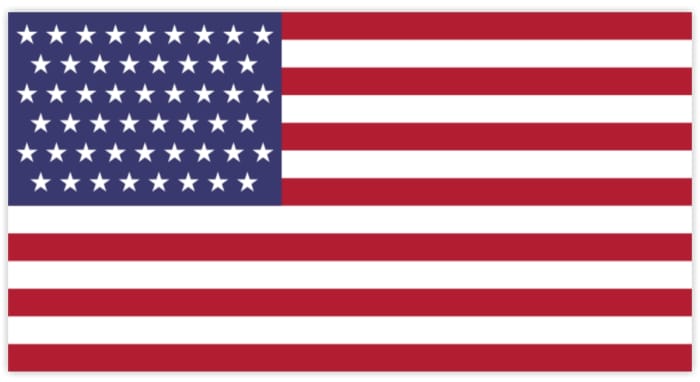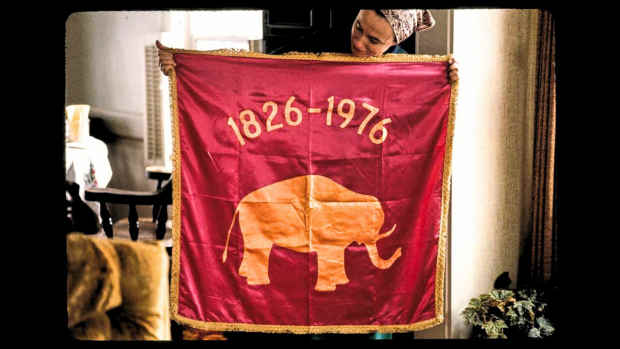20 Most Beautiful and Best Flags in the World
What Are the Best and Most Beautiful Flags in the World?
Each country in the world has its own national flag. A national flag is a piece of cloth with a unique design usually displayed on a flagpole. It represents a country and its people. It is one of the most important and respected symbols of a country and the emblem of freedom and sovereignty.
We can see flags everywhere we look in our everyday life. Flags are flown over schools, offices, and public places and carried by athletes in international competitions, as a symbol of pride, for the country that they represent. They come in many colors and are depicted with various geometric features and common symbols.
The motifs found in a flag's design typically have deep-rooted meaning and are generally associated with the history and culture of the country. This article discusses 20 of the best national flag designs in the world.
20. Kiribati
Kiribati's flag is one of the coolest in the world. It depicts sunset on the shores of the Pacific nation of Kiribati. The flag is made up of a red upper field, a yellow frigate bird, a gold sun, and a sea of three white and three blue wavy lines.
The bird symbolizes strength, independence, and Kiribati tribal dance rhythms. The sun represents the country's location at the equator. The sea is the Pacific Ocean, which surrounds the archipelago.
The wavy white and blue lines represent the three island groups—the Gilbert Islands, the Phoenix Islands, and the Line Islands. The 17 rays of the sun represent the 16 Gilbert Islands and the Banaba.
19. South Korea
The primary color for the Korean flag is white, universally acknowledged as the traditional color in that nation. Korean traditional clothing was made of white fabric.
White also refers to the widespread tranquility that characterizes and draws to mind the nation's moniker, "Land of the Morning Calm." The circular image in the center, the um-yang, represents balance in the universe.
The four black trigrams that surround the um-yang explicitly depict the happenings and harmony of the universe.
These remind us of the four cardinal directions (north, east, south, west), four seasons (fall, winter, spring, summer), four natural elements (water, air, fire, earth), four main members of the family (father, mother, son, daughter), and the four most important celestial bodies (heaven, earth, sun, moon).
18. Serbia
The Serbian flag has horizontal bands of three colors—red, blue, and white—that stand for the bloodshed in their country (red), the freedom it symbolizes (blue), and the mother's milk that strengthens Serbian children (white).
The tricolor is portrayed with a crowned coat of arms. Beneath the crown, a double-headed eagle is depicted as a representation of the equality of divine and human authority. The eagle is adorned with a small red shield with a cross and bears four arrows and two gold lilies.
Recommended
17. Côte d’Ivoire
The flag of Côte d’Ivoire is divided into three vertical bars color of green, white, and orange. Orange symbolizes national development; white stands for peace and unification; and green is for hope.
The colors of the flag also depict the country's landscape—the white represents Côte d’Ivoire as a whole, the green represents the dense forests that line the country's southern coast, and the orange stands for the dry savannas in the north.


16. Bangladesh
The Bangladeshi flag can be described as a red circle on a green field. The green field reflects the nation's lushness in forest and greenery and the red circle symbolizes the blood of the martyrs who gave their lives to preserve the nation's independence. The flag most likely serves as a memorial to the heroism of their ancestors.
This flag is one of the most iconic flags in the world. It is infamous for its red circle off-center placement so that it appears centered when raised on the pole.
15. Bhutan
Bhutan's national flag is a banner with a dragon on it. The dragon symbolizes the country's nickname: "Land of the Thunder Dragon." In Bhutanese mythology, thunder is thought to be the sound of dragons.
The dragon is white, which is a symbol of the purity and loyalty of the country. The dragon holds gems, symbolizing the nation's prosperity and excellence. The yellow-orange and red-orange stripes of the flag are diagonally separated. Yellow-orange represents the government of Bhutan, whereas red-orange represents Buddhism, the country's principal religion.
14. Estonia
The flag of Estonia is three-colored with three horizontal bands of blue, black, and white. Blue stands for faith, loyalty, and devotion; black represents the dark history of the country, and white signifies enlightenment and virtue. The design looks very simple but has a special meaning.
Nature is the cornerstone of the Estonian culture, thus the source of inspiration for their flag is natural scenery. The design is derived from the winter forest on the horizon—blue is the sky, black is the dark forest, and white is the winter snow that covers the ground.
13. Lebanon
Lebanon's flag is made up of a horizontal red-white-red pattern with a green cedar tree in the center.
The white field with a tree is based on snow-covered Lebanon Mountain, where cedar trees continue to thrive. The color white is also associated with purity and tranquility. The cedar tree, mentioned in Biblical passages, represents Maronite Christians. The tree also represents joy, prosperity, eternal life, and purity.
The red stripes signify the bloodshed of people who died to gain the country’s independence.
12. Nauru
Nauru is a small island nation in Oceania. The flag of Nauru is an abstract map of the nation, representing the country's geographical position. The blue field represents the Pacific Ocean, the yellow horizontal line in the middle denotes the equator of the Earth, and the 12-pointed star shows the exact location of the country on the map.
Because the country is located below the equator, the star lies under the yellow line. And the star is likewise somewhat on the left of the flag due to its location to the left of the International Date Line. The star's 12 rays signify the country's 12 unique tribes.
11. Japan
The Japanese national flag is a simple design consisting of a red disc on a white background. Known as "Nisshoki," which translates to "the sun-mark flag," or the "Ball of the Sun," the white denotes purity and honesty while the red disc signifies the sun.
Since the beginning of Japan's history, the sun has been a central symbol of culture and religion. Amaterasu, the Japanese goddess of the sun, is the mythical founder of Japan and the progenitor of Japan's rulers. It is said that she lifted Japan from the depths of the sea, giving the country its familiar name "The Land of the Rising Sun."
The sun also represents the location of Japan in the Far East of Asia; Japan is the first place where the sun rises on the Asian continent.
10. Austria
Austria's flag is divided into three horizontal stripes of red, white, and red. It is one of the world's oldest flags, having been used since 1230.
The flag is said to have been inspired by a duke's white cloth that had been stained by blood after a battle. The only part that wasn’t discolored was the one covered by his belt. When the duke removed his belt, he was taken aback by the red-white-red pattern he saw, and used it in his heraldry.


9. Uzbekistan
One-third of countries have religious symbols on their national flag to represent their beliefs, ideals, and rituals. The national flag of Uzbekistan is special because it contains not only a religious symbol but the history of the Uzbek religions.
Green, as well as the crescent moon on the canton, symbolizes Islam, the most prevalent religion of the country. White stands for Zoroastrianism, the ancient pre-Islamic religion of the country. Blue signifies the blue sky, which is the abode of God. The two thin red stripes that separate the three major colors represent the minority religions.
The 12 stars beside the crescent moon represent the 12 imams of Islam, the 12 zodiac signs of the horoscopes, and the 12 months of the year. The arrangement of the 12 stars forms the word “Allah” in Arabic script.
8. Israel
Since Israel is the only Jewish majority country in the world, Israelis depicted Jewish symbols in their national flag. The six-pointed star at the center is referred to as the Star of David. It is the best-known symbol of Judaism. It signifies the Jewish God, Yahweh, and is used as a decoration in churches and other religious buildings.
The two blue stripes in the flag are derived from the stripes of the traditional Jewish prayer shawl, which is called a tallit. Tallit is worn during worship and other religious ceremonies. The colors are symbolic too. The blue represents heaven, the throne of God, and the white field is for God's benevolence.


7. Ukraine
The national flag of Ukraine is another simple but meaningful design. It holds the country's sobriquet, "the breadbasket of Europe." Ukraine has been given this nickname because of its massive agricultural production and vast fields of wheat and other food products.
The flag is reminiscent of a golden wheat field under the bright blue sky. The blue is the sky and the yellow is the golden wheat field.
6. United States of America
The U.S. flag is also called the "Star-Spangled Banner" or "Old Glory." It bears both the past and present history of the United States. The 50 stars represent the 50 U.S. states, while the 13 stripes represent the 13 original states, which were initially British colonies that declared independence from Great Britain.
The colors of the flag also have meanings—blue represents vigilance, perseverance, and justice; red signifies hardiness and valor, and white is for purity and innocence.
Furthermore, the U.S. flag is completely modular. It can be modified without affecting its overall aesthetic by adding a star on the flag each time a state joins the union. It has been modified 26 times since its creation in 1776. In fact, the current design is not permanent—it will be replaced by a flag with 51 stars if a new state joins the union.

The United States has prepared a flag with 51 stars that will be used in case a new state joins the American union.
5. The Philippines
The Philippine national flag has equal bands of blue and red colors. The blue band means peace, truth and justice, whereas the red band means war, patriotism, valor, and bloodshed of the people who fought for independence.
At the hoist is a white equiangular triangle that symbolizes equality, liberty, and fraternity. At the center of the triangle is a sun that symbolizes hope, freedom, people's democracy, and sovereignty. The eight rays of the sun stand for the first eight provinces which initiated a revolution against Spanish rule.
The three stars, one at each corner of the triangle, stand for the three major groups of islands—Luzon, Visayas, and Mindanao. The color of the celestial bodies themselves, which is gold or yellow, is for the richness of its natural resources.
The Philippine flag is the only flag in the world that has colors that swap. The red stripe can switch with the blue stripe—effectively achieved by flipping the flag upside down—indicating whether the Philippines is in a state of peace or war. When the blue stripe is on top of the red stripe, it means that the country is in a state of peace. When the red stripe faces up and the blue stripe goes down, it means the country is in a state of war.
The history of the Philippine flag being flown upside down includes World War II, the Filipino-American War, and the Japanese occupation.






















